 | | | Switch to: Europe, USA, New Zealand, Antarctica Credit: NOAA/Ovation  Planetary K-index Planetary K-index
Now: Kp= 5.00 storm
24-hr max: Kp= 5.00 storm
explanation | more data
Interplanetary Mag. Field
Btotal: 12.35 nT
Bz: -2.18 nT south
more data: ACE, DSCOVR
Updated: Today at 1146 UT  Coronal Holes: 30 Nov 22 Coronal Holes: 30 Nov 22 
Solar wind flowing from this equatorial coronal hole should reach Earth on Dec. 1st or (more likely) the 2nd. Credit: SDO/AIA  Noctilucent Clouds Noctilucent Clouds
The summer season for northern noctilucent clouds has ended; the southern season will begin in November. Switch view: Europe, USA, Asia, Polar Updated Nov30  SPACE WEATHER
NOAA Forecasts | | Updated at: 2022 Nov 30 2200 UTC FLARE | 0-24 hr | 24-48 hr | CLASS M | 01 % | 01 % | CLASS X | 01 % | 01 % |  Geomagnetic Storms: Geomagnetic Storms:
Probabilities for significant disturbances in Earth's magnetic field are given for three activity levels: active, minor storm, severe storm Updated at: 2022 Nov 30 2200 UTC Mid-latitudes | 0-24 hr | 24-48 hr | ACTIVE | 40 % | 35 % | MINOR | 25 % | 20 % | SEVERE | 05 % | 05 % | High latitudes | 0-24 hr | 24-48 hr | ACTIVE | 10 % | 10 % | MINOR | 25 % | 30 % | SEVERE | 60 % | 50 % | | | |  | | | | | | | | | | | Never miss another geomagnetic storm. Sign up for Space Weather Alerts and you'll receive a text message when magnetic storms erupt. Aurora tour guides and professional astronomers use this service. You can, too! | | | FAST SOLAR WIND: Today, Earth is inside a stream of fast-moving solar wind with speeds occasionally topping 700 km/s. The action of the stream is sparking G1-class geomagnetic storms around the Arctic Circle. Aurora alerts: SMS Text. A TINY SPACECRAFT IN DEEP SPACE: This week, NASA's Orion spacecraft reached its farthest distance from Earth -- 268,563 miles away. That's farther than any other human-rated spacecraft in the history of the Space Age. Astronomer Gianluca Masi of Ceccano, Italy, photographed Orion approaching the farpoint: 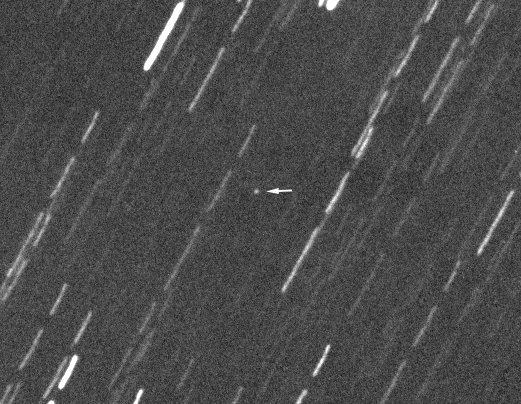
"Taking such a picture was quite difficult," says Masi . "The spacecraft is only 5 meters in diameter, and at this extreme distance it was fainter than a 16th magnitude star. I managed to capture Orion using the Virtual Telescope Project's robotic facility in Italy. The telescope tracked Orion's apparent motion, this is why stars look like long trails while the probe is a sharp dot of light." While Masi was photographing Orion, Orion was photographing Masi. This is what the spacecraft saw looking back at Earth: 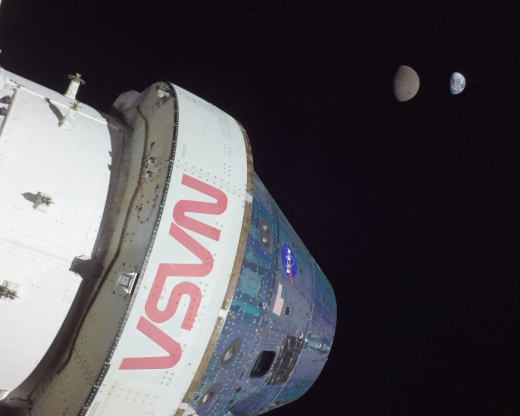
As seen from Orion, Earth and the Moon had nearly identical gibbous phases. We've all seen a gibbous Moon, but the one Orion saw was different. The daylit landscape was all farside--the side of the Moon invisible from Earth. Orion was more than 40,000 miles above the Moon's farside at the time of the snapshot. Orion is now halfway through its 25.5 day mission to the Moon. NASA says the spacecraft remains in healthy condition as it continues its journey in distant retrograde lunar orbit. Orion is set to return to Earth on Dec. 11th with a record-hot reentry and a splashdown in the Pacific Ocean. Check NASA's Artemis blog for updates. Realtime Space Weather Photo Gallery
Free: Spaceweather.com Newsletter STORM TROOPER WHISKEY GLASS: If you like your drink cold--really cold--this glass is for you. On Nov. 25th, it flew to the stratosphere onboard an Earth to Sky Calculus cosmic ray research balloon. At the apex of the flight (117,109 ft), the temperature was a frosty -63C: 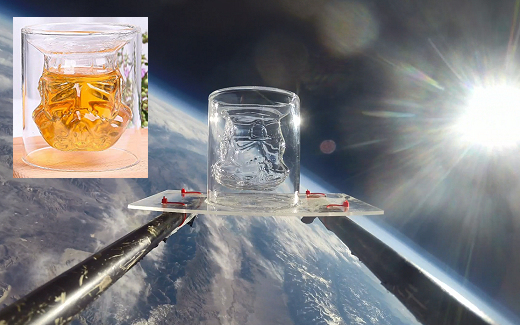
You can have it for $99.95. This double-walled whiskey glass is cast from one of the original molds for Storm Trooper helmets used in Star Wars: A New Hope in 1977. Made of high quality borosilicate, the glass is thin, hard and lead-free. It makes a great Christmas gift for Star Wars fans. The glass comes with a greeting card showing the item in flight, and telling the story of its journey to the stratosphere and back again. Far Out Gifts: Earth to Sky Store
All sales support hands-on STEM education
Realtime Aurora Photo Gallery
Free: Spaceweather.com Newsletter Every night, a network of NASA all-sky cameras scans the skies above the United States for meteoritic fireballs. Automated software maintained by NASA's Meteoroid Environment Office calculates their orbits, velocity, penetration depth in Earth's atmosphere and many other characteristics. Daily results are presented here on Spaceweather.com. On Nov 30, 2022, the network reported 20 fireballs.
(19 sporadics, 1 Nov. omega Orionid) 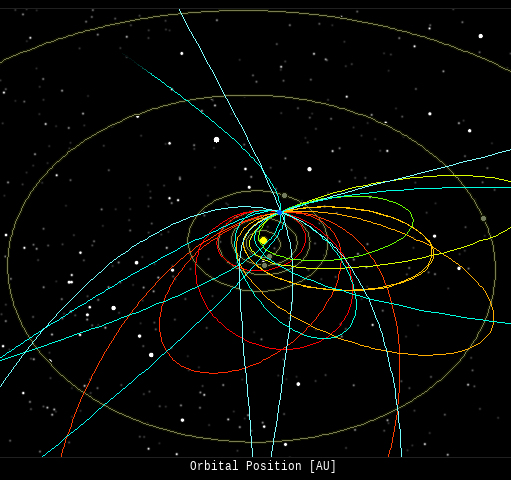 In this diagram of the inner solar system, all of the fireball orbits intersect at a single point--Earth. The orbits are color-coded by velocity, from slow (red) to fast (blue). [Larger image] [movies] Potentially Hazardous Asteroids ( PHAs) are space rocks larger than approximately 100m that can come closer to Earth than 0.05 AU. None of the known PHAs is on a collision course with our planet, although astronomers are finding new ones all the time. On November 30, 2022 there were 2316 potentially hazardous asteroids.
 | Recent & Upcoming Earth-asteroid encounters: | Asteroid | Date(UT) | Miss Distance | Velocity (km/s) | Diameter (m) | | 2022 WO4 | 2022-Nov-25 | 11 LD | 10.9 | 46 | | 2022 WA2 | 2022-Nov-25 | 3.9 LD | 9.8 | 18 | | 2022 WY3 | 2022-Nov-25 | 8.8 LD | 6.5 | 26 | | 2022 WU4 | 2022-Nov-25 | 11.6 LD | 14.7 | 33 | | 2022 WY | 2022-Nov-25 | 11.2 LD | 6.8 | 16 | | 2022 WG8 | 2022-Nov-25 | 17.6 LD | 9.7 | 49 | | 2022 UD72 | 2022-Nov-26 | 10.6 LD | 4.3 | 20 | | 2022 WB8 | 2022-Nov-26 | 18.3 LD | 3.7 | 14 | | 2022 WE7 | 2022-Nov-27 | 2.6 LD | 16.9 | 9 | | 2022 WP5 | 2022-Nov-27 | 15.9 LD | 14.4 | 43 | | 2022 WO2 | 2022-Nov-27 | 15.2 LD | 10 | 23 | | 2022 VQ | 2022-Nov-27 | 7.6 LD | 8.2 | 28 | | 2022 WN9 | 2022-Nov-27 | 0.1 LD | 16.9 | 4 | | 2022 WM7 | 2022-Nov-28 | 0.2 LD | 11.6 | 4 | | 2022 WS5 | 2022-Nov-29 | 4.9 LD | 11.7 | 25 | | 2022 VB2 | 2022-Nov-29 | 9 LD | 8.4 | 33 | | 2022 WP8 | 2022-Nov-30 | 14.5 LD | 8.5 | 53 | | 2022 WE5 | 2022-Nov-30 | 4.1 LD | 8.5 | 11 | | 2022 WO7 | 2022-Nov-30 | 12.8 LD | 10.4 | 45 | | 2022 WK1 | 2022-Dec-01 | 14.2 LD | 12.2 | 39 | | 2022 WT9 | 2022-Dec-01 | 13.9 LD | 10.1 | 29 | | 2022 WS9 | 2022-Dec-01 | 4.6 LD | 18.1 | 36 | | 2022 WT6 | 2022-Dec-02 | 4.7 LD | 20.2 | 21 | | 2009 HV58 | 2022-Dec-02 | 12.3 LD | 28.8 | 419 | | 2022 UT8 | 2022-Dec-02 | 11.1 LD | 4.2 | 71 | | 2022 WG9 | 2022-Dec-03 | 12.5 LD | 10.6 | 34 | | 2017 QL33 | 2022-Dec-03 | 16 LD | 6.9 | 193 | | 2022 WD2 | 2022-Dec-03 | 7.3 LD | 7.4 | 25 | | 2010 VQ | 2022-Dec-03 | 11.3 LD | 3.9 | 10 | | 2022 WR9 | 2022-Dec-03 | 7.2 LD | 13 | 13 | | 2022 WO5 | 2022-Dec-04 | 19.2 LD | 9.1 | 40 | | 2022 WQ5 | 2022-Dec-04 | 5.8 LD | 11.6 | 27 | | 2022 WB5 | 2022-Dec-05 | 5.8 LD | 11 | 27 | | 2022 VP1 | 2022-Dec-05 | 17.3 LD | 7.1 | 56 | | 2022 WA6 | 2022-Dec-06 | 4.4 LD | 13.9 | 22 | | 2022 WV8 | 2022-Dec-06 | 15.6 LD | 7.2 | 30 | | 2022 WF8 | 2022-Dec-06 | 8.8 LD | 7.6 | 13 | | 2022 WK9 | 2022-Dec-07 | 6.1 LD | 14.3 | 33 | | 2022 WW | 2022-Dec-10 | 19.2 LD | 6.2 | 30 | | 2019 XY | 2022-Dec-10 | 3.6 LD | 12.9 | 9 | | 2003 YS70 | 2022-Dec-13 | 10.4 LD | 4.1 | 5 | | 2019 XQ1 | 2022-Dec-13 | 14.5 LD | 9.8 | 30 | | 2018 XU3 | 2022-Dec-13 | 14.8 LD | 10.3 | 28 | | 2021 XS4 | 2022-Dec-14 | 14.5 LD | 9.7 | 23 | | 2015 RN35 | 2022-Dec-15 | 1.8 LD | 5.9 | 85 | | 2016 YE | 2022-Dec-18 | 18.6 LD | 4.8 | 23 | | 2014 HK129 | 2022-Dec-20 | 6.7 LD | 11.6 | 216 | | 2017 XQ60 | 2022-Dec-21 | 18.8 LD | 16 | 45 | | 2022 UD9 | 2022-Dec-22 | 4.6 LD | 10.3 | 159 | | 2022 RD2 | 2022-Dec-22 | 13.9 LD | 1.1 | 7 | | 2013 YA14 | 2022-Dec-25 | 2.7 LD | 10.5 | 68 | | 2022 TE14 | 2022-Dec-25 | 11.2 LD | 7 | 127 | | 2018 YK2 | 2022-Dec-26 | 15.8 LD | 15.1 | 98 | | 2022 WV9 | 2022-Dec-27 | 6.6 LD | 7.4 | 45 | | 2010 XC15 | 2022-Dec-27 | 2 LD | 10.1 | 182 | | 2021 AE | 2022-Dec-28 | 16.5 LD | 15 | 23 | | 2021 NF | 2023-Jan-02 | 17.9 LD | 11.3 | 40 | | 2011 WR41 | 2023-Jan-03 | 15.8 LD | 8.9 | 34 | | 2019 AY3 | 2023-Jan-04 | 16.8 LD | 19.7 | 62 | | 2021 TL | 2023-Jan-09 | 14.2 LD | 8.5 | 75 | | 2014 LJ | 2023-Jan-14 | 4.8 LD | 3.5 | 7 | | 2012 BV13 | 2023-Jan-16 | 12.2 LD | 6.7 | 134 | | 2020 BP | 2023-Jan-20 | 5.2 LD | 16.9 | 26 | | 2019 BO2 | 2023-Jan-24 | 12.1 LD | 16.2 | 21 | | 2019 BZ4 | 2023-Jan-24 | 16.5 LD | 5.6 | 20 | | 2020 BZ14 | 2023-Jan-26 | 8.8 LD | 6.7 | 54 | Notes: LD means "Lunar Distance." 1 LD = 384,401 km, the distance between Earth and the Moon. 1 LD also equals 0.00256 AU. | | Cosmic Rays in the Atmosphere | SPACE WEATHER BALLOON DATA: Almost once a week, Spaceweather.com and the students of Earth to Sky Calculus fly space weather balloons to the stratosphere over California. These balloons are equipped with sensors that detect secondary cosmic rays, a form of radiation from space that can penetrate all the way down to Earth's surface. Our monitoring program has been underway without interruption for 7 years, resulting in a unique dataset of in situ atmospheric measurements. Latest results (July 2022): Atmospheric radiation is decreasing in 2022. Our latest measurements in July 2022 registered a 6-year low: 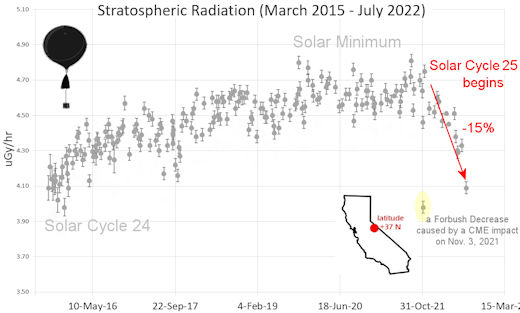
What's going on? Ironically, the radiation drop is caused by increasing solar activity. Solar Cycle 25 has roared to life faster than forecasters expected. The sun's strengthening and increasingly tangled magnetic field repels cosmic rays from deep space. In addition, solar coronal mass ejections (CMEs) sweep aside cosmic rays, causing sharp reductions called "Forbush Decreases." The two effects blend together to bring daily radiation levels down. .Who cares? Cosmic rays are a surprisingly "down to Earth" form of space weather. They can alter the chemistry of the atmosphere, trigger lightning, and penetrate commercial airplanes. According to a study from the Harvard T.H. Chan school of public health, crews of aircraft have higher rates of cancer than the general population. The researchers listed cosmic rays, irregular sleep habits, and chemical contaminants as leading risk factors. A number of controversial studies (#1, #2, #3, #4) go even further, linking cosmic rays with cardiac arrhythmias and sudden cardiac death. Technical notes: The radiation sensors onboard our helium balloons detect X-rays and gamma-rays in the energy range 10 keV to 20 MeV. These energies span the range of medical X-ray machines and airport security scanners. Data points in the graph labeled "Stratospheric Radiation" correspond to the peak of the Regener-Pfotzer maximum, which lies about 67,000 feet above central California. When cosmic rays crash into Earth's atmosphere, they produce a spray of secondary particles that is most intense at the entrance to the stratosphere. Physicists Eric Regener and Georg Pfotzer discovered the maximum using balloons in the 1930s and it is what we are measuring today. | | The official U.S. government space weather bureau | | | The first place to look for information about sundogs, pillars, rainbows and related phenomena. | | | Researchers call it a "Hubble for the sun." SDO is the most advanced solar observatory ever. | | | 3D views of the sun from NASA's Solar and Terrestrial Relations Observatory | | | Realtime and archival images of the Sun from SOHO. | | | information about sunspots based on the latest NOAA/USAF Active Region Summary | | | current counts of failed and deployed Starlink satellites from Jonathan's Space Page | | | Authoritative predictions of space junk and satellite re-entries | | | from the NOAA Space Environment Center | | | fun to read, but should be taken with a grain of salt! Forecasts looking ahead more than a few days are often wrong. | | | from the NOAA Space Environment Center | | | the underlying science of space weather |  | BestCSGOGambling is the best site for everything related to CSGO gambling on the web |  | To find reviews of new online casino sites in the UK try The Casino DB where there are hundreds of online casino reviews complete with bonuses and ratings. Alternatively, Online-Casinos.xyz is another massive directory of online casinos listing sites for the UK and Worldwide. Casinos that offer Rupees for bonuses are very generous to Indian players. Find the best online casinos in India at AllCasinos.in Looking for a new online casino? Try Casimpo the new site dedicated to making online casino simple, or check out the new Avenger Slots Casino and Ace Online Casino with over 500 online slots and casino games. |  | One of the most popular casino games is the Book Of Dead Slot based on ancient Egyptian text, you can find all the casinos with spins at bookofdeadslotsites.com. |  | When looking for casinos to play online when the weather is bad, you can try casino online trucchi for Italian games. If you are not from Finland you can try the Swedish page Svenska casino online to find suitable games, check out svenskacasinoonline.net. Always check your local laws before playing with real money. |  | Looking for sports betting companies not registered on GamStop? CasinoGap has presented a list of sites not on GamStop available for UK players. Check and bet online! Would you like to bet at sites not using GamStop? Look at a list of NonStopCasino sites for online betting that aren't on GamStop. Top-rated bookmakers ever! | | | These links help Spaceweather.com stay online. Thank you to our supporters! | | | | | | | | |  | |  |   | ©2021 Spaceweather.com. All rights reserved. This site is penned daily by Dr. Tony Phillips. | |

